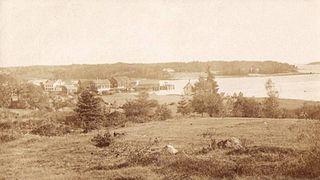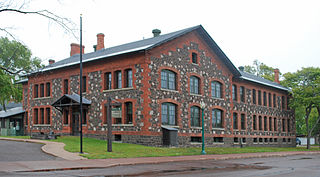
Vinland, Vineland, or Winland was an area of coastal North America explored by Vikings. Leif Eriksson landed there around 1000 AD, nearly five centuries before the voyages of Christopher Columbus and John Cabot. The name appears in the Vinland Sagas, and describes Newfoundland and the Gulf of Saint Lawrence as far as northeastern New Brunswick. Much of the geographical content of the sagas corresponds to present-day knowledge of transatlantic travel and North America.

An out-of-place artifact is an artifact of historical, archaeological, or paleontological interest found in an unusual context, which challenges conventional historical chronology by its presence in that context. Such artifacts may appear too advanced for the technology known to have existed at the time, or may suggest human presence at a time before humans are known to have existed. Other examples may suggest contact between different cultures that is hard to account for with conventional historical understanding.

Brooklin is a town in Hancock County, Maine, United States. The population was 827 at the 2020 census.

Olaf III or Olaf Haraldsson, known as Olaf the Peaceful, was King of Norway from 1067 until his death in 1093.
Magnus Haraldsson was King of Norway from 1066 to 1069, jointly with his brother Olaf Kyrre from 1067. He was not included in official Norwegian regnal lists until modern times, but has since been counted as Magnus II.

The Maine penny, also referred to as the Goddard coin, is a Norwegian silver coin dating to the reign of Olaf Kyrre King of Norway (1067–1093 AD). It was claimed to be discovered in Maine in 1957, and it has been suggested as evidence of Pre-Columbian trans-oceanic contact.

Keweenaw National Historical Park is a unit of the U.S. National Park Service. Established in 1992, the park celebrates the life and history of the Keweenaw Peninsula in the Upper Peninsula of the U.S. state of Michigan. It is a federal-local cooperative park made up of two primary units, the Calumet Unit and the Quincy Unit, and almost two dozen cooperating "Heritage Sites" located on federal, state, and privately owned land in and around the Keweenaw Peninsula. The National Park Service owns approximately 1,700 acres (690 ha) in the Calumet and Quincy Units. Units are located in Baraga, Houghton, Keweenaw, and Ontonagon counties.

Spiro Mounds is an Indigenous archaeological site located in present-day eastern Oklahoma. The site was built by people from the Arkansas Valley Caddoan culture. that remains from an American Indian culture that was part of the major northern Caddoan Mississippian culture. The 80-acre site is located within a floodplain on the southern side of the Arkansas River. The modern town of Spiro developed approximately seven miles to the south.

Werowocomoco was a village that served as the headquarters of Chief Powhatan, a Virginia Algonquian political and spiritual leader when the English founded Jamestown in 1607. The name Werowocomoco comes from the Powhatan werowans (weroance), meaning "leader" in English; and komakah (-comoco), "settlement". The town was documented by English settlers in 1608 as located near the north bank of the York River in what is now Gloucester County. It was separated by that river and the narrow Virginia Peninsula from the English settlement of Jamestown, located on the James River.
Timerevo is an archaeological site near the village of Bolshoe Timeryovo, seven kilometers southwest of Yaroslavl, Russia, which yielded the largest deposits of early medieval Arabic coins in Northern Europe.

Colonial Pemaquid State Historic Site is a publicly owned historic property operated by the state of Maine near Pemaquid Beach in Bristol, Maine. The site includes the reconstructed Fort William Henry, archaeological remains of 17th- and 18th-century village buildings and fortifications, and a museum with artifacts found on the site including musket balls, coins, pottery, and early hardware.

The Beardmore Relics are a cache of Viking Age artifacts, said to have been unearthed near Beardmore, Ontario, Canada in the 1930s. The cache consists of a Viking Age sword, an axe head, and a bar of undetermined use.

The Point Peninsula complex was an indigenous culture located in Ontario and New York from 600 BCE to 700 CE. Point Peninsula ceramics were first introduced into Canada around 600 BCE then spread south into parts of New England around 200 BCE. Some time between 300 BCE and 1 CE, Point Peninsula pottery first appeared in Maine, and "over the entire Maritime Peninsula." Little evidence exists to show that it was derived from the earlier, thicker pottery, known as Vinette I, Adena Thick, etc... Point Peninsula pottery represented a new kind of technology in North America and has also been called Vinette II. Compared to existing ceramics that were thicker and less decorated, this new pottery has been characterized by "superior modeling of the clay with vessels being thinner, better fired and containing finer grit temper." Where this new pottery technology originated is not known for sure. The origin of this pottery is "somewhat of a problem." The people are thought to have been influenced by the Hopewell traditions of the Ohio River valley. This influence seems to have ended about 250 CE, after which they no longer practiced burial ceremonialism.
Mound 34 is a small platform mound located roughly 400 metres (1,300 ft) to the east of Monks Mound at Cahokia Mounds near Collinsville, Illinois. Excavations near Mound 34 from 2002 to 2010 revealed the remains of a copper workshop, although the one of a kind discovery had been previously found in the late 1950s by archaeologist Gregory Perino, but lost for 60 years. It is so far the only remains of a copper workshop found at a Mississippian culture archaeological site.
Hvítárholt is a settlement located on the banks of the Hvítá in Hrunamannahreppur, Árnessýsla, Iceland. It is one of the earliest settlements to have been excavated in Iceland, and the excavation yielded important information on early building construction, plus a Roman coin.

The Dumaw Creek Site is an archaeological site designated 20OA5, located along Dumaw Creek northeast of Pentwater, Michigan, that was the location of a 17th-century village and cemetery. It is one of the youngest pre-historic sites in Michigan, dating to the terminal Late Woodland Period just prior to European contact. It was listed on the National Register of Historic Places in 1972.

Viking coinage was used during the Viking Age of northern Europe. Prior to the usage and minting of coins, the Viking economy was predominantly a bullion economy, where the weight and size of a particular metal is used as a method of evaluating value, as opposed to the value being determined by the specific type of coin. By the ninth century, the Viking raids brought them into contact with cultures well familiarised with the use of coins in economies of Europe, hence influencing the Vikings own production of coins.
The Gavin Watson Site, designated Site 59.8 by the Maine Archaeological Survey, is a prehistoric archaeological site in Sullivan, Maine. Located on the shore of Flanders Bay, an inlet off Frenchman Bay in Down East Maine, the site is a refuse midden that is free of shells. An important regional multicomponent site with artifacts spanning thousands of years, it was listed on the National Register of Historic Places in 1987.
Flye Point 2, also designated Site 42.43 by the Maine Archaeological Survey, is a prehistoric archaeological site in Brooklin, Maine. This site includes a large shell midden, and has yielded evidence of human habitation, including "pit house" features, with an estimated occupation time of 1000 CE. The midden is one of the largest of its type on the coast of eastern Maine. It was listed on the National Register of Historic Places in 1985.
The Atkinson-Koskinen Site, designated 45.13 by the Maine Archaeological Survey, is a prehistoric archaeological site in or near Steuben, Maine. Its main feature is a non-shell refuse midden, a rarity on the coast of eastern Maine. Along with the Goddard Site in Brooklin, it is important in analyzing land use and subsistence patterns during the Late Ceramic period. The site was listed on the National Register of Historic Places in 1984.












